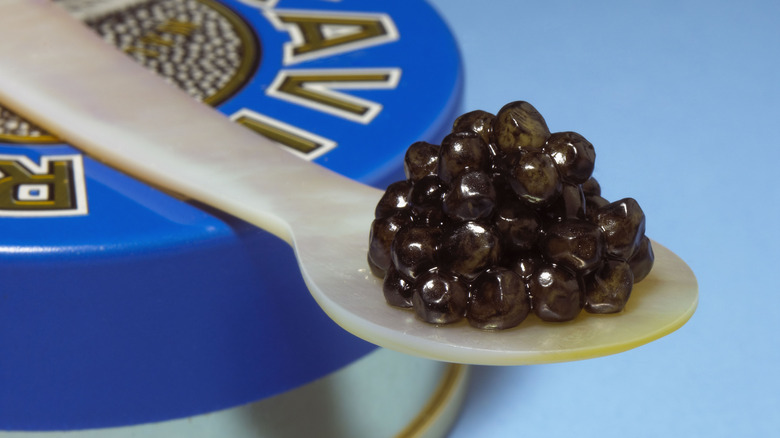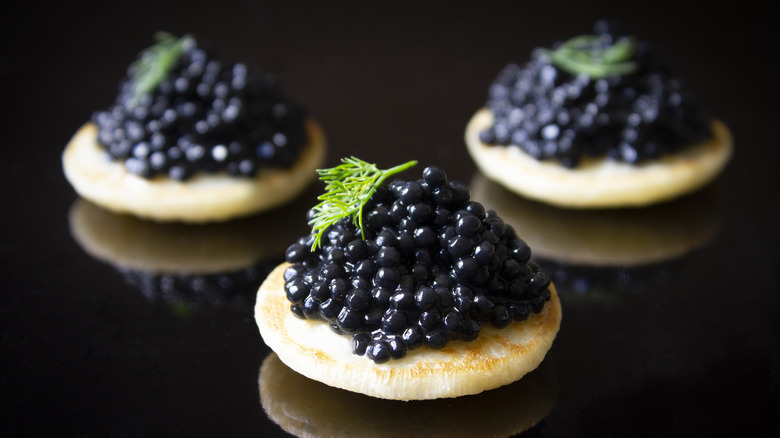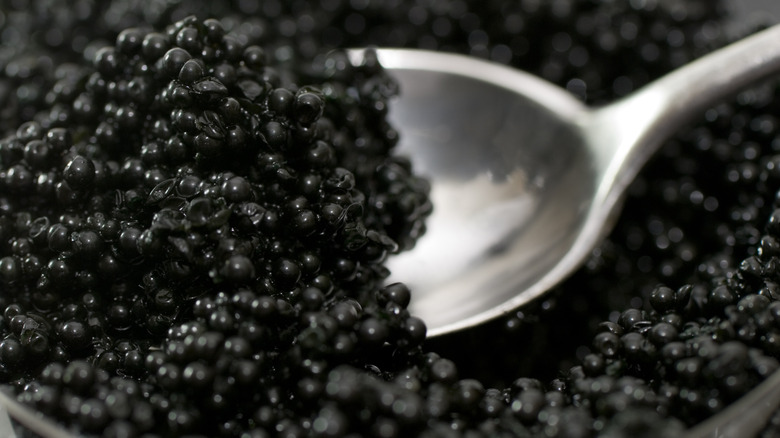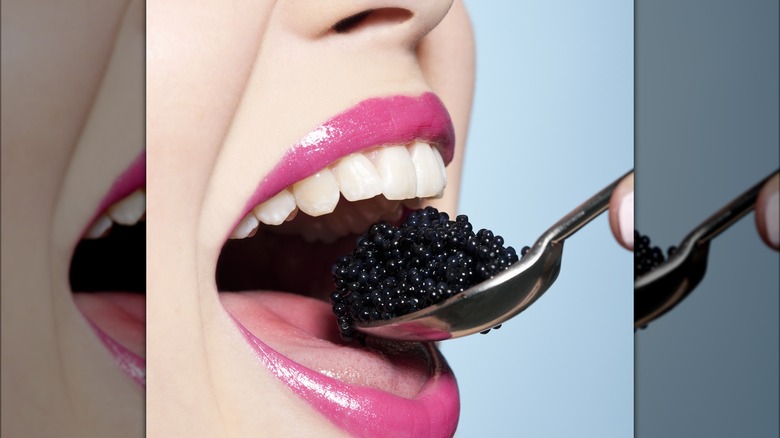The Differences That Set Fake Caviar Apart From The Real Deal
From the shell spoon to a bump off the wrist, caviar is a luxury food item for gastronomic history. Not a fan? There's probably a good chance that you've never had the real thing — even if the packaging said otherwise.
Caviar has been infamously mislabeled for decades. Now, the USDA regulates caviar labeling and manufacturing to ensure authenticity, and quality standards and consistently high demand keep the prices sharp. But selling fake caviar advertised as the real thing is often a sneaky marketing tactic from retailers, as the high price tag that real caviar necessitates scares off many buyers.
But don't get it twisted: When we say "fake caviar," we aren't talking about sturgeon or roe. We mean the totally non-roe substitute made from produce like fruits, veggies, or fungi. It's often altered and flavored with herbs and spices to mimic the taste, texture, and appearance of real caviar, and some imitations do a pretty convincing job with a hefty price tag to match. But if you're going to shell out, make sure you're shelling out for the real deal.
Pro tip: If the packaging simply says "caviar," it has to come from sturgeon. If it's any other product, it must be specified as such. But separating the roe from the faux can be especially tough to differentiate when you're purchasing caviar from online retailers. How can you be sure what you're getting?
Taste, texture, and appearance differences
Perhaps the most revealing giveaway between real and fake caviar is its exterior appearance. Real caviar totes a glossy silver sheen, while fake caviar tends to be softer and mushy, with an opaque dullness. Texturally, caviar is a multitudinous beast ranging from firm and crunchy to smooth and creamy. But in general, real caviar tends to be firmer and toothsome — while aside from an initial pop or crunch, the texture of fake caviar leaves something to be desired. As opposed to real caviar's miniature, uniform spheres, fake caviar also tends to be irregularly shaped, with some pieces even being physically larger than others. (It's a side effect of some synthetic caviar alternatives containing compounds like sodium alginate and sodium chloride to hold the round, compact shape.)
The other key differentiator is taste. Real caviar totes a distinctly fishy, salty flavor — an ultra-savory umami bomb. Like a high-quality wine, it remains on the tongue long after it's been tasted, opening up in complexity as more idiosyncratic characteristics unfold. Fake caviar, by stark contrast, often contains the eggs of other fish, which often present a slightly sweet taste and a decidedly one-dimensional flavor profile: salty or sweet, and that's all.
Origin, production, and price
Real caviar has a long history of being high in value. In ancient Rome, a fistful of black caviar was worth 100 sheep; a few thousand years later, Tsar Nicholas II of Russia accepted caviar as a form of payment from tax-paying fishermen. It's always been expensive because it's always been labor-intensive to harvest — so if you're adamant about getting the real stuff, expect to pay more. On designated sturgeon farms in California, for instance, caviar extraction is subjected to strict quality-assurance checkpoints at every step of the process. As such, fake caviar costs less than the real deal but can still set you back a pretty penny.
An ounce of golden osetra caviar runs for $320 on average, while paddlefish caviar still fetches $55. Beluga sturgeon caviar costs more than red salmon roe, but it's a fitting markup for the higher quality. Black and golden sturgeon caviar should have similar price tags since they both come from the same fish; if there's a big price discrepancy between the two, the cheaper one is probably fake.
A trustworthy vendor will list details on the farm or natural source from which the fish was obtained. You should be able to trace your black beluga caviar to its farm of origin. To make sure you're getting what you pay for, look into potential retailers' aquaculture practices. You might even contact a customer service representative or reach out to verified industry buyers like local restaurants to vet your potential plug.
Is fake caviar worth it?
Is fake caviar worth its lower price? The short answer is: It depends. As a novelty garnish, fake caviar can be a cheaper alternative and an awesome ingredient for getting creative in the kitchen. It works for flavorful dishes that might not rely on multidimensional caviar flavor, like a caviar-topped crispy potato galette with dill. It'd make a great salty garnish for sweet potato pancakes with crème fraîche or even a smoked salmon benedict for a double fishy presentation.
There are lots of different faux caviar options on the market to suit your recipes, too, including regional variations. Salmon, lumpfish, whitefish, paddlefish, bowfin, trout, mackerel, tobiko, masago, and herring all produce decent alternatives to sturgeon caviar. There's even meatless faux caviar made from couscous flavored with butter and dyed black with sepia ink, or boiled soy spheres aromatized in yuzu or wasabi.
Beyond that, use fake caviar with a pearl of discretion. When quality counts, only the real thing fits the bill. Le Bernardin's Chef Eric Ripert prefers a minimal preparation to let the world-class flavors of high-quality caviar speak for themselves. However you serve it, enjoy your caviar with a side of informed consumerism — and a glass of champagne or top-shelf vodka.



